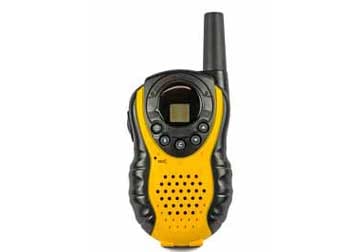PMR446: Licence Free Personal Radio Service
Notes and details describing what PMR446 is and how it operates as a UHF licence free personal radio service.
Licence free radio systems:
Licence free radio systems
Citizens band, CB
PMR446
FRS Family Radio Service
How to use a licence free radio
Hints & tips on buying licence free radio
PMR446 is a licence free personal radio service that is available in most European countries and a few others that have also adopted the standard.
PMR446 enables unlicensed walkie talkies to be used for personal of business use.
Many businesses have adopted PMR 446 as it enables them to have a low cost radio communications system without the need for a licence or other requirements. Walkie talkies are readily available and for a reasonable cost dependent upon the facilities they provide and the robustness needed.

Apart from being used by businesses, they are also widely used as a personal radio service for individuals where they can enable communication to be made cheaply and easily using two way walkie talkie radios.
PMR446 standard
The PMR446 standard provides the requirements to which all licence free PMR446 radios must be built. As such the standard limits some of the facilities that may be enjoyed by users of other systems.
There are a few overall limitations to the PMR446 service:
- The radio communications equipment must be hand-portable
- Only speech transmissions are allowed.
Although the idea of PMR446 is to enable straightforward radio communications devices to be used license free by untrained users, there are a number of facilities in addition to the basic transmit and receive functions that are allowed. Privacy measures including speech inversion are permitted with PMR 446 radios. In addition to this the inclusion of broadcast (AM/FM) radio receivers in PMR446 radios is allowed where there is no provision for the received broadcast signal to be re-transmitted on the PMR 446 radio frequencies.
A variety of accessories can be used with PMR 446 radios:
- External microphones including VOX type microphones
- Earphones, headphones and external loudspeakers; and
- DC power sockets, charge sockets and battery packs.
These accessories can be used provided that they are connected using appropriate sockets installed by the manufacturer at the time of manufacture and conformance evaluation. The use of these accessories must not affect the RF characteristics of the radios.
In all cases, the use of these facilities must not cause any change to, or effect on, the performance characteristics of the PMR 446 radio, as permitted under the Wireless Telegraphy (Exemption) Regulations (SI 1999/930).
it is also not allowed for PMR446 radios to be connected to the Public Switched Telephone Network (PSTN) or other telephone networks.
To check on the latest position regarding the use of PMR446 and see the progress made by CEPT member countries in implementing the Decisions, visit the European Radiocommunications Office (ERO) website at www.ero.dk.
PMR446 frequencies & channels
PMR446 utilises a European standard managed by CEPT. Although the PMR 446 frequencies and channels are harmonised across Europe, not all countries allow their use, so check with the relevant authorities before using them.
There are eight PMR466 channels or PMR466 frequencies in total. These are spaced 12.5kHz apart from each other. Although there are not many channels, the short range normally means that levels of interference are tolerably low.
| PMR446 Channel Allocations | |
|---|---|
| PMR466 Channel | PMR 446 Frequency (MHz) |
| 1 | 446.00625 |
| 2 | 446.01875 |
| 3 | 446.03125 |
| 4 | 446.04375 |
| 5 | 446.05625 |
| 6 | 446.06875 |
| 7 | 446.08125 |
| 8 | 446.09375 |
Use of PMR446 frequencies and interference
The PMR446 frequencies are shared and users may experience interference and channel sharing problems in areas such as densely populated areas in cities, etc. where usage is high.
The problems associated with the high levels of use of the PMR446 frequencies may be reduced by changing frequency. Other systems such as CTCSS tone and DCS codes may also help in alleviating problems.
In view of the unlicensed nature of PMR446 and the possible high usage of the frequencies, the scheme is not suitable for safety of life use or for users who need to have access to frequencies at particular locations and times.
PMR446 equipment
Equipment for PMR446 must be type-approved before being sold and used. There are restrictions on the equipment. No external antenna can be used, although facilities like CTCSS and DCS codes are allowable.
Wireless & Wired Connectivity Topics:
Mobile Communications basics
2G GSM
3G UMTS
4G LTE
5G
Wi-Fi
Bluetooth
IEEE 802.15.4
DECT cordless phones
Networking fundamentals
What is the Cloud
Ethernet
Serial data
USB
LoRa
VoIP
SDN
NFV
SD-WAN
Return to Wireless & Wired Connectivity



